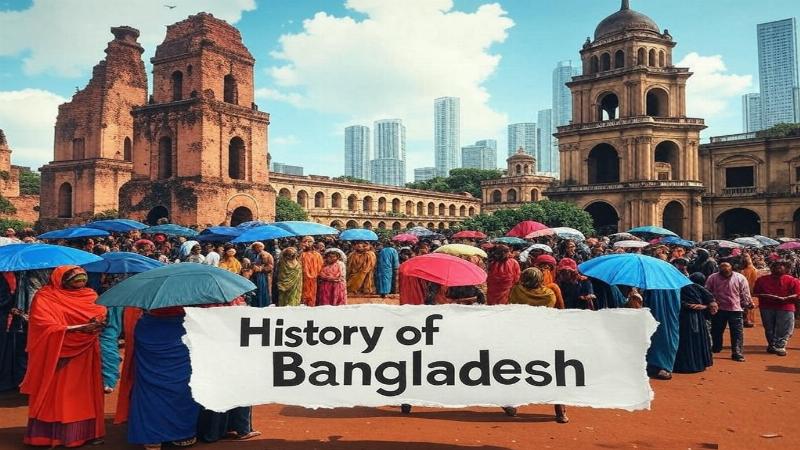Place for ads

Bangladesh, a lush delta nation in South Asia, is a land where rivers weave through history as richly as they do its landscape. Covering 147,570 square kilometers, it sits at the confluence of the Ganges, Brahmaputra, and Meghna rivers, bordered by India and Myanmar. Known today for its vibrant culture and rapid growth, Bangladesh’s past is a saga of ancient kingdoms, colonial struggles, and a fierce fight for identity. In this article, we’ll trace Bangladesh’s journey from its earliest days to its modern emergence, exploring the milestones that have shaped this resilient nation.
Bangladesh’s history begins in the Stone Age, with evidence of human presence dating to around 20,000 BCE. Tools from the Paleolithic era, found in the Chittagong Hill Tracts, suggest early hunter-gatherers roamed its fertile plains. By 2000 BCE, Neolithic farmers settled the riverbanks, cultivating rice—a staple that defines Bangladeshi life today.
The Bronze Age brought the Mahasthangarh site, near Bogra, where 3rd-century BCE relics hint at urban life. Indo-Aryan migrations around 1000 BCE introduced Vedic culture, blending with local Dravidian and Austroasiatic peoples. This fusion laid the roots of Bengal’s distinct identity, marked by language and agriculture.
By
Place for ads
The Pala dynasty (8th–12th centuries) elevated Bengal’s status, with kings like Dharmapala building monasteries like Somapura Mahavihara—a UNESCO site. Tantric Buddhism flourished, while the Sena dynasty (11th–13th centuries) shifted to Hinduism, enriching Bengali literature with poets like Jayadeva.
Islam arrived in the 13th century with Turkish conqueror Bakhtiyar Khilji, who defeated the Senas in 1204. The Delhi Sultanate ruled Bengal, followed by independent sultans like Ilyas Shah (1342–1358), who made it a trade hub linking China to the Middle East. Mosques like the Sixty Dome in Bagerhat reflect this era’s grandeur.
The Mughal Empire annexed Bengal in 1576 under Akbar, with Dhaka (then Dacca) rising as a provincial capital. Cotton textiles—muslin—dazzled the world, while rice exports fed Mughal wealth. Mughal decline in the 18th century left Bengal vulnerable, paving the way for European incursions.
The British East India Company seized Bengal after the 1757 Battle of Plassey, defeating Nawab Siraj-ud-Daulah. By 1793, the Permanent Settlement taxed farmers heavily, sparking famines—none worse than the 1770 Bengal Famine, killing 10 million. Dhaka faded as Calcutta rose, but resistance simmered.
The 1857 Sepoy Mutiny echoed in Bengal, though British rule tightened. Railroads and jute mills modernized the east—now Bangladesh—but wealth flowed outward. Bengali intellectuals like Raja Ram Mohan Roy pushed reforms, while the 1905 partition of Bengal (reversed in 1911) fueled nationalist fervor.
Britain’s 1947 partition split Bengal—West Bengal joined India, while East Bengal became East Pakistan. With 55 million people, it was Pakistan’s populous half, united by Islam but divided by 1,600 kilometers and language—Bengali versus Urdu. Dhaka became its capital, but West Pakistan’s dominance bred discontent.
The 1952 Language Movement erupted when Urdu was imposed—students died protesting on February 21, now International Mother Language Day. Sheikh Mujibur Rahman emerged, leading the Awami League to demand autonomy. Cyclones, like the 1970 Bhola disaster killing 300,000, exposed West Pakistan’s neglect.
In 1970, the Awami League won Pakistan’s elections, but West Pakistan refused to cede power. On March 25, 1971, the Pakistan Army launched Operation Searchlight, massacring civilians in Dhaka. Mujib declared independence on March 26, sparking the Bangladesh Liberation War.
Mukti Bahini guerrillas, backed by India, fought a nine-month struggle. Atrocities—3 million killed, 200,000 women raped—galvanized resistance. On December 16, 1971, Pakistan surrendered in Dhaka, birthing Bangladesh. Mujib, freed from prison, became its first leader, hailed as “Bangabandhu” (Friend of Bengal).
Independence brought hope but chaos. Mujib’s 1972 socialist policies faced famine and corruption, ending with his 1975 assassination in a coup. General Ziaur Rahman seized power, shifting to a market economy and founding the Bangladesh Nationalist Party (BNP). His 1981 assassination led to General Hussain Muhammad Ershad’s 1982 coup.
Ershad ruled until 1990, when mass protests forced his resignation. Democracy returned with Khaleda Zia (BNP) winning in 1991, followed by Sheikh Hasina (Awami League) in 1996—Mujib’s daughter—alternating power in a bitter rivalry that defines Bangladeshi politics.
Today, Bangladesh’s 170 million people drive a booming economy—garments lead exports, lifting millions from poverty. Dhaka, a megacity of 20 million, pulses with energy, while rural life clings to rice paddies. The 2013 Rana Plaza collapse (1,134 dead) spurred labor reforms, and remittances from 10 million overseas workers fuel growth.
Challenges loom—floods, climate change, and Rohingya refugees (1 million since 2017). Hasina’s rule since 2009 has brought stability but accusations of authoritarianism. Culture—Rabindranath Tagore’s poetry, Lalon Shah’s songs—remains a soulful thread.
Bangladesh’s history is a testament to endurance—from ancient Bengal’s glory to colonial scars, partition’s pain to liberation’s triumph. Its rivers mirror its spirit, flowing through adversity to a vibrant present. As Bangladesh strides forward, its past fuels a legacy of courage and hope.
Place for ads